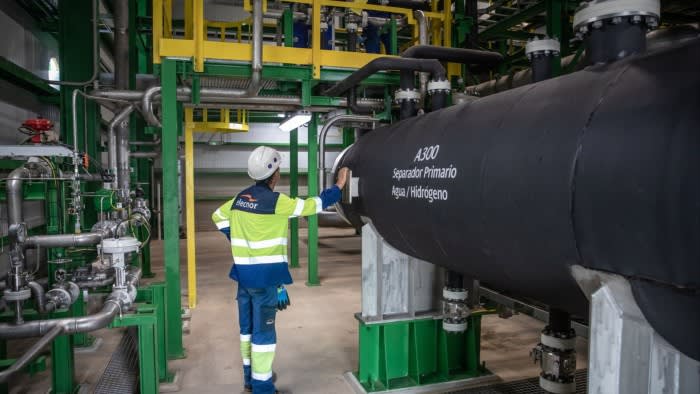This article is an onsite version of our Energy Source newsletter. Premium subscribers can sign up here to get the newsletter delivered every Tuesday and Thursday. Standard subscribers can upgrade to Premium here, or explore all FT newsletters
Good morning and welcome back to Energy Source, coming to you from London.
US foreign policy has long been shaped by the need to secure oil for American consumers, but it has been less common for Washington to intervene abroad to improve US access to metals.
The energy transition has changed that. The need for critical minerals to build clean energy infrastructure is deemed so important that the US has sought to facilitate a deal for a Swiss trading house to acquire mines in the Democratic Republic of Congo, Harry Dempsey and I reported yesterday.
The previously unreported initiative, spearheaded by President Joe Biden’s senior energy adviser Amos Hochstein, is one of the clearest examples yet of the energy transition reshaping foreign policy priorities.
I expect it to the be first of many attempts by Washington to help more metals flow back to US-friendly companies as competition with China for access to critical minerals intensifies.
Our main item in today’s Energy Source, from Shotaro Tani, investigates another aspect of energy transition competition with China: electrolysers.
Thanks for reading — Tom
‘Europeanising’ Chinese green tech?
In the past year, two Chinese companies have announced their intentions to manufacture electrolysers, a technology needed to produce green hydrogen, in Europe. One company, Guofu Hydrogen, is looking at setting up a factory in Germany, while another, Peric, signed a licensing agreement with a Swedish company, which allows it to make Chinese electrolysers in Europe.
What makes the deals interesting is that they come at a time when the EU is actively cracking down on Chinese clean technology, from wind and solar to electric vehicles.
Electrolysers, which are used to split hydrogen from water, have not been part of the clampdown yet. Part of the reason is that Chinese electrolysers play a relatively small role in the European market.
For example, in a recent Hydrogen Bank auction run by the European Commission, set up to provide subsidies to the cheapest new projects, 70 per cent of the 132 bids were planning to use EU manufactured electrolysers, according to Veyt, a carbon consultancy.
The EU already has the Net-Zero Industry Act, which sets a 40 per cent European manufacturing target for technologies in the clean energy space, including hydrogen electrolysers, by 2030. But more stringent measures could be on the way, especially with European manufacturers calling for support, arguing that China’s subsidies for its state-owned hydrogen companies had created a “skewed playing field”.
The European industry believes the moves by the Chinese manufacturers to set up factories on the continent are aimed at dodging potential future crackdowns, by essentially “Europeanising” their products.
Chinese manufacturers were looking to “increase their acceptability and resilience when and if Europe decides to introduce local content requirements, as well as to anticipate any anti-dumping investigations”, said Daniel Fraile, chief policy officer at Hydrogen Europe, an industry body.
Fredrik Mowill, chief executive of electrolyser manufacturer Hystar, agrees. “I think the main motivation is to say, ‘Hey, this is made in Europe, not made in China’ . . . Possibly Europeanise the product.”
Making electrolysers in China has cost advantages. Veyt believes that, while not an apples to apples comparison, Chinese electrolyser manufacturers can deliver their products in China “at between a fifth and third of the price” that European manufacturers can deliver within Europe for certain types of electrolysers (and more on the cost side from an industry executive here).
Chinese manufacturers making electrolysers in Europe would diminish that cost competitiveness, something that Guofu admits will happen in the short term. But “electrolysers are an equipment that needs a lot of maintenance and refurbishment”, Justin Gu, head of overseas business at Guofu, said.
“If you don’t have a local facility you cannot provide the service required . . . We believe in this complete lifetime, the overall cost with local production will be cheaper than being based in China,” he said.
Gu added that the aim of setting up manufacturing capabilities in Germany was not primarily to meet European regulations, with Guofu establishing similar facilities in other parts of the world.
“We are setting up factories around the world for the same purpose; to globalise our business,” he said. “If the European policy will favour local production . . . this is a good thing for us, because we are ready for that. But this is not the main reason we want to move to Europe.” He added that he wasn’t aware of any Chinese state subsidies towards electrolyser manufactures.
Hystar’s Mowill believes that if there is a level playing field, and Chinese manufacturers adhere to Europe’s safety and environmental standards, competition is a plus for the market.
“It is good for driving down the cost of green hydrogen and making sure we can increase the speed of deployment of green hydrogen,” he said. “The market and the customers will decide which companies and products they select . . . At the end of the day, you want low-cost green hydrogen.” (Shotaro Tani)
Power Points
Energy Source is written and edited by Jamie Smyth, Myles McCormick, Amanda Chu, Tom Wilson and Malcolm Moore, with support from the FT’s global team of reporters. Reach us at energy.source@ft.com and follow us on X at @FTEnergy. Catch up on past editions of the newsletter here.
Recommended newsletters for you
Moral Money — Our unmissable newsletter on socially responsible business, sustainable finance and more. Sign up here
The Climate Graphic: Explained — Understanding the most important climate data of the week. Sign up here


